Delicacies
Hot buns and roast lamb
Updated: 2011-04-23 05:38
By Pauline D. Loh (China Daily)
As the world gets smaller, festive food is no longer restricted to particular cultures or beliefs. Pauline D. Loh remembers some traditional Easter food.
Boarding school meals are nothing to write home about, but the cooks at my junior college did try to make it as festive as possible for those of us who came from a different country and a different culture. I remember being entranced by the customs and food of Easter, with a countdown that started long before Easter. Shrove Tuesday was pancake day, and we always had pancakes. This was the last Tuesday before the Lent period began, Lent being the period of abstinence before Easter - so I suppose the pancakes with the lashings of sticky golden syrup were a sort of "last indulgence".
At chapel during the same period, we were told of the origins of the Holy Week, during which Christians commemorate Christ's journey and final sacrifice on the cross. It included Holy Thursday or Maundy Thursday, a day also known as foot-washing day.
Good Friday, of course, would be the start of the Easter weekend, which would culminate on Easter Sunday, the day Christians all over the world celebrate the resurrection of Jesus Christ.
Throughout that long weekend, the dining room would have a pile of currant buns with a single white cross of icing on them. These were the hot cross buns, and I was initially fascinated by them, having heard of them only in the nursery rhymes. Besides, we could have as many of the buns as we wanted.
Instead of the hot and angry buns of my imagination, they were crusty but soft buns flavored with familiar spices and studded with black currants. Most of us loved licking the icing off the top of the bun best.
Later, in the library, my own curiosity prompted research into the origins of these buns. I learned that they had a history that went back far beyond Christianity. The Anglo-Saxons first baked little wheat cakes in honor of their goddess of spring, Eostre, just one of the many pagan deities that the old country folks believed in. As Britain slowly converted to Christianity, the Church substituted little breads that had been blessed and made the people forgo the pagan cakes.
Easter Sunday was when we all trooped off to the cathedral in town for morning service. The highlight was when we returned to school, because roast lamb would be served, with all the trimmings of fresh mint sauce and baked potatoes.
I always found it a little difficult to reconcile the serving of lamb after a morning sermon on the sacrifice of Christ, the Lamb of God. But then, the platter of aromatic lamb studded with rosemary and garlic would appear on the table and my juvenile reservations evaporated.
Even the roast lamb had history. It stemmed from the Jewish celebration of the first Passover, in which the angel of God spared the first-born sons of the captive Jews in Egypt in households marked by the blood of a sacrificial lamb. The lamb was roasted and served with unleavened bread and bitter herbs such as rosemary and thyme. With the coming of Christianity, the traditions became one.
And now, of course, you can find hot cross buns and roast lamb served at any hotel in any city in any part of the world during the Easter period. Perhaps this is a sign that the world is indeed becoming more tolerant of each other's rites and beliefs - at least, it's a start when people enjoy each other's food.
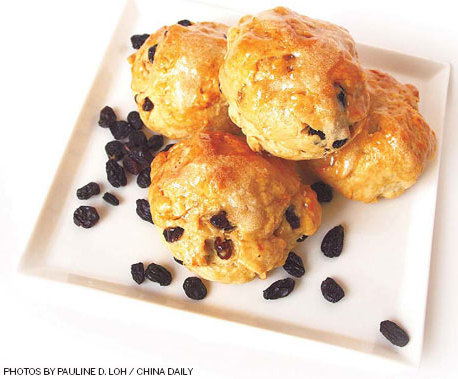
Recipe | Hot cross buns
Ingredients:
250 g strong bread flour
250 g plain flour
150 ml warm milk
10 g instant yeast Finely grated zest of 1 orange
1 tsp cinnamon or five-spice powder
2 tsp salt
50 g butter, melted
1 medium free-range egg, beaten
200 g dried fruit - raisins, currants, dried peel
For plain white dough:
50 g plain flour
1/2 cup water
1 tbsp jam
1 tsp hot water
Method:
1. Combine bread flour and plain flour, yeast, salt in a large mixing bowl.
2. Add the warm milk, egg and melted butter.
3. Mix together until a soft dough is formed. Knead until smooth and silky.
4. Add the orange zest and dried fruits.
5. Knead to mix in the fruits and then cover the dough in a large bowl and leave to rise in a warm place until doubled in size.
6. Knock back the dough and divide into 10 portions. Shape into rounds, place on a baking tray and dust with a little flour. Allow to rise a second time.
7. While dough is rising, prepare the white dough for the crosses by mixing enough water into the plain flour until smooth and thick. Pipe a cross on top of each bun.
8. Bake the buns in a hot oven of 200 deg C for about 15 to 20 minutes.
9. Prepare the glaze by combining the jam and hot water. Blend well and brush over the buns as soon as you remove them from the oven. Cool slightly and serve warm.
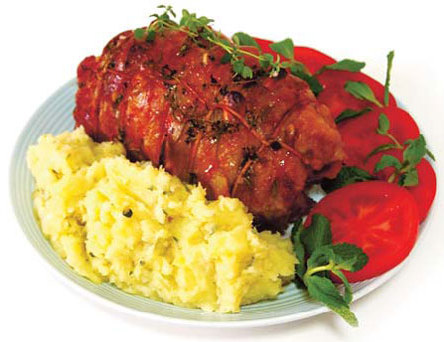
Recipe | Garlic & Rosemary roast lamb
Ingredients:
1 to 1.2 kg lamb leg or lamb shoulder
10 cloves of garlic, peeled and sliced
1 sprig rosemary
2 tbsp sea salt flakes
Method:
1. You need to start this recipe one or even two days ahead. Scrub the lamb with half the sea salt flakes and stab it all over with a sharp knife, tucking in the slices of garlic into the slits.
2. Strip the rosemary sprig of its leaves and stuff the leaves into the slits as well.
3. Scatter the rest of the salt over the lamb and place it into a large zip-lock bag.
4. Allow the lamb to marinate for at least 24 hours, more if you can afford the time.
5. On the day you want to serve the lamb, take it out of the fridge well in advance and let it come to room temperature.
6. Place the lamb on a rack in a baking tray and pour some water into the tray, but not so much that it touches the lamb. The water will keep the lamb moist as it bakes.
7. Place lamb in the middle of a hot oven at 220 deg C. Roast for 30 minutes. Turn down the heat to 200 deg C and roast for another 30 minutes.
8. If you see the top of the lamb browning too quickly, cover with a piece of foil. This should give you a medium rare to medium done piece of lamb, just slightly pink on the bone.
9. Serve the lamb sliced, with mint sauce and mashed potatoes, seasoned with salt and pepper.
Recipe | Fresh mint sauce
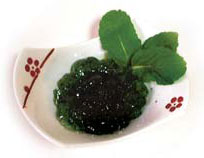
Ingredients:
1 large bunch fresh mint
1/2 cup honey
1 tsp corn starch plus
1 tbsp water Juice of half a lemon
Method:
1. Finely chop the fresh mint.
2. Dissolve the corn starch with water and add to the honey and lemon juice.
3. Heat the mixture over very low heat until it starts to thicken and turn clear. Remove from heat and stir in the chopped mint.
4. Chill the sauce until it sets. Garnish with fresh mint sprigs and serve with the lamb.
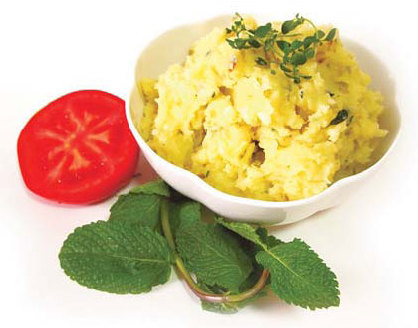
Recipe | Garlic mashed potatoes
Ingredients:
1 kg potatoes, skinned and cut into quarters
4-6 cloves garlic, peeled
1 tsp salt A few sprigs thyme, chopped
Method:
1. Place potato pieces and garlic cloves in a saucepan and cover with water.
2. Cook over high heat until water boils. Turn down to a simmer and cook until potatoes are soft.
3. Drain the water and mash the potatoes and garlic with enough salt to taste. Fold in the chopped thyme. Serve hot with the lamb.
Specials
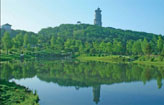
Urban breathing space
City park at heart of industrial hub positions itself as top tourism attraction

On a roll
Auto hub Changchun also sets its sight on taking lead in railway sector

The stage is set
The Edinburgh International Festival will have a Chinese flavor this year.